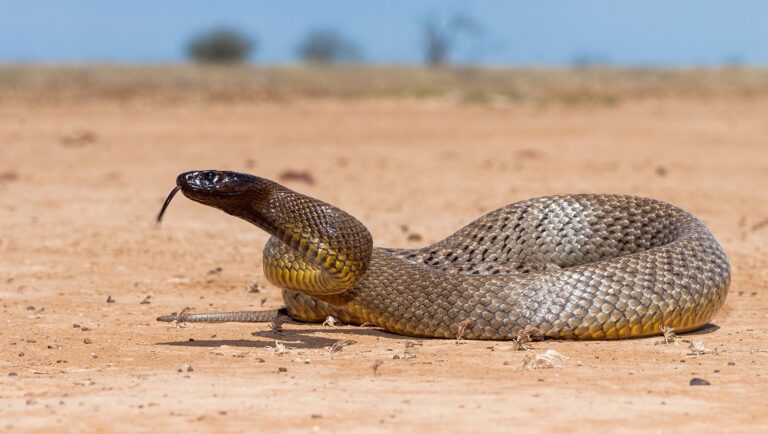When it comes to venomous snakes, some species stand out for their potent venom and deadly bites. Here are the top 10 most venomous snakes in the world.
Don’t miss to checkout: Top 10 Snakes in the World
List of the Top 10 Venomous Snakes in the World.
Explore our list of the top 10 venomous snakes in the world, picked up by our editorial team. Feel free to share the one you love the most.
1. Inland Taipan
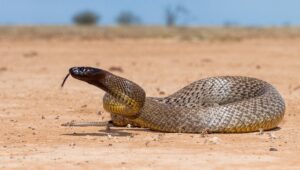
The Inland Taipan, also known as the “fierce snake,” is considered the most venomous snake in the world. This elusive reptile is found in the arid regions of central Australia and is known for its potent venom, which can be lethal to humans if not treated promptly. The Inland Taipan is a relatively small snake, with adults typically growing to around six feet in length. It has a slender body and an olive-green coloration, with darker patches along its back. Despite its small size, this snake packs a powerful punch in terms of venom. The venom of the Inland Taipan is highly potent, containing a mix of neurotoxins, hemotoxins, and myotoxins. When injected into its prey, the venom quickly paralyzes the nervous system, causing respiratory failure and death. While bites from this snake are extremely rare, they are considered a medical emergency and require immediate treatment with antivenom. In the wild, the Inland Taipan primarily preys on small mammals, such as rats and mice. It uses its potent venom to quickly immobilize its prey before swallowing it whole. The snake has heat-sensing pits on its head, which allow it to detect the body heat of its prey, even in complete darkness.
2. Eastern Brown Snake
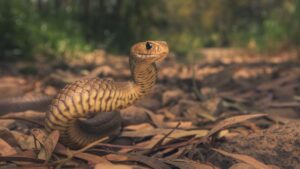
The Eastern Brown Snake is a highly venomous snake species native to Australia. Known for its potent venom and potentially lethal bite, this snake is considered one of the most dangerous in the world. Belonging to the family Elapidae, the Eastern Brown Snake is characterized by its slender body and distinctive brown coloration. It can grow up to 2 meters in length and is a fast and agile hunter. This snake primarily preys on small mammals, birds, and reptiles, using its venom to immobilize and digest its prey. The venom of the Eastern Brown Snake is a potent cocktail of neurotoxins and myotoxins, which can cause paralysis, respiratory failure, and tissue damage in humans. A bite from this snake can be life-threatening if not treated promptly with antivenom. It is crucial to seek medical assistance immediately in the event of a snake bite from an Eastern Brown Snake. Eastern Brown Snakes are found in a wide range of habitats, including woodlands, grasslands, and urban areas. They are often encountered in backyard gardens, along waterways, and in agricultural fields. Due to their adaptable nature, these snakes have been known to thrive in human-altered environments, increasing the potential for human-wildlife conflicts. If you come across an Eastern Brown Snake in the wild, it is essential to give the snake space and not provoke or antagonize it. These snakes are generally shy and will avoid confrontation with humans if given the opportunity to retreat. It is best to observe these snakes from a safe distance and appreciate them from afar.
3. Coastal Taipan
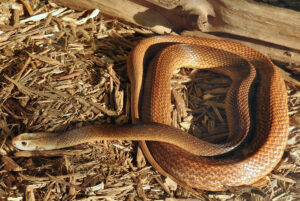
The Coastal Taipan, also known as the common taipan or simply taipan, is a highly venomous snake native to Australia. It is considered one of the most dangerous snakes in the world due to its potent venom and aggressive behavior. The Coastal Taipan is a large snake, with adults reaching lengths of up to 2.9 meters (9.5 feet). They are typically light to dark brown in color, with a slightly lighter underside. Their scales are smooth and glossy, giving them a sleek and intimidating appearance. These snakes are primarily found in the coastal regions of northern and eastern Australia, where they inhabit a variety of habitats, such as forests, grasslands, and swamps. They are known for their excellent hunting skills, using their speed and agility to catch prey such as rodents, birds, and small mammals. The venom of the Coastal Taipan is extremely potent, containing a mix of neurotoxins and hemotoxins that can quickly incapacitate their prey. For humans, a bite from a Coastal Taipan can be fatal if not treated promptly. Symptoms of envenomation include severe pain, swelling, paralysis, and eventually respiratory failure. Conservation efforts are underway to protect the Coastal Taipei and its habitat, as deforestation and urban development are posing a threat to their population numbers. Education and awareness campaigns are also being conducted to teach people how to safely coexist with these snakes and what to do in case of a snakebite emergency.
4. Tiger Snake
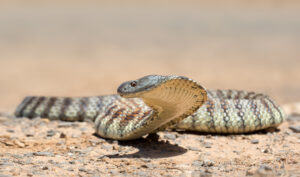
The Tiger Snake, scientifically known as Notechis scutatus, is a venomous snake native to the southern regions of Australia. Named for its distinctive yellow and black striped patterning that resembles that of a tiger, this species is highly regarded for its potent venom and unique appearance. Tiger snakes typically grow to an average length of 1–1.5 meters, with females being slightly larger than males. They are known for their slender bodies, triangular-shaped heads, and prominent eyes. Their coloring can vary from olive-green to dark brown, with the characteristic yellow stripes running along their bodies. These snakes are predominantly found in coastal regions, wetlands, and grasslands in southern Australia, where they prey on a variety of small mammals, birds, and frogs. Tiger snakes are known for their aggressive nature when threatened and will not hesitate to strike if they feel threatened, or cornered. One of the most notable features of the Tiger Snake is its potent venom, which is neurotoxic and coagulant in nature. Despite their dangerous reputation, tiger snakes play a crucial role in their ecosystem by helping to control populations of small rodents and insects. In recent years, habitat destruction and urbanization have posed significant threats to the Tiger Snake population. Conservation efforts are in place to help protect these snakes and their habitats, as they are an important part of Australia’s unique biodiversity. One interesting fact about tiger snakes is their ability to produce live young, known as viviparity. This means that instead of laying eggs, female tiger snakes give birth to fully-formed young, typically in the late summer months. These baby snakes are independent from birth and they must fend for themselves in the wild.
5. Black Mamba
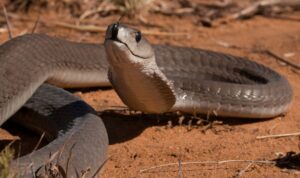
The Black Mamba, known scientifically as Dendroaspis polylepis, is not only one of the deadliest snakes in the world but also one of the fastest. Found predominantly in sub-Saharan Africa, this highly venomous snake strikes fear into the hearts of many due to its potent neurotoxic venom and aggressive nature. What sets the Black Mamba apart from other snakes is its incredible speed. Capable of slithering at speeds of up to 12 miles per hour, this snake is known for its swift and aggressive attacks when it feels threatened. With its lightning-fast reflexes and deadly venom, the Black Mamba is a force to be reckoned with in the animal kingdom. The venom of the Black Mamba is a potent neurotoxin that attacks the nervous system, causing paralysis and eventually death if left untreated. Just one bite from this deadly snake can deliver enough venom to kill several adults within hours. Due to the severity of its venom, the Black Mamba is considered one of the most dangerous snakes in the world. Encounters with the Black Mamba are rare, as these elusive snakes tend to avoid human contact when possible. However, when threatened or cornered, the Black Mamba will not hesitate to defend itself with a series of rapid strikes and bites. It is important for humans to exercise caution and respect when encountering this deadly serpent in the wild.
6. Belcher Sea Snake
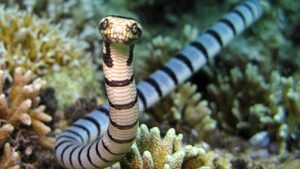
Belcher’s Sea Snake, also known as the faint-banded sea snake, is a unique and intriguing species that can be found in the waters of Southeast Asia and Northern Australia. These venomous serpents are known for their striking appearance and fascinating behavior, making them a subject of interest for researchers and nature enthusiasts alike.
One of the most distinctive features of Belcher’s Sea Snake is its beautiful coloration. These snakes have alternating bands of black, yellow, and white along their bodies, giving them a striking and eye-catching appearance. This coloration serves as a warning to potential predators, indicating that the snake is venomous and should be avoided. Belcher’s Sea Snake is a highly venomous species, with venom that is potent enough to kill a human. However, despite their toxic nature, these snakes are not aggressive and will typically only bite if provoked or threatened. In fact, human encounters with Belcher’s Sea Snake are rare, as they are generally shy and elusive creatures that prefer to avoid confrontation. These snakes are highly adapted to life in the ocean, with flattened tails that allow them to move efficiently through the water. They are excellent swimmers and can often be seen gliding gracefully through the sea in search of prey. Belcher’s Sea Snake primarily feeds on small fish and eels, using their highly specialized venom to immobilize their prey before consuming it.
7. Saw scaled Viper
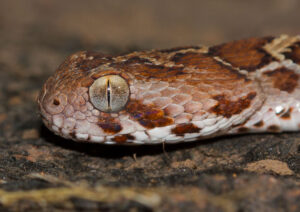
The saw-scaled viper, known for its distinct saw-like scales on its body, is a highly venomous snake found in parts of Africa, the Middle East, and Asia. This dangerous pit viper is known for its aggressive nature and potent venom, making it a formidable predator in its natural habitat. With a maximum length of around three feet, the Saw-scaled Viper may not be the largest snake in the world, but it certainly packs a deadly punch. Its venom is hemotoxic, meaning it destroys red blood cells and disrupts the clotting process, leading to severe internal bleeding and organ failure in its prey. Despite its small size, the Saw-scaled Viper is responsible for numerous snakebite incidents each year, particularly in rural areas where access to medical treatment is limited. The snake’s venom can be fatal if not promptly treated with antivenom, making it a significant public health concern in regions where it is prevalent. In addition to its potent venom, the Saw-scaled Viper is also known for its aggressive behavior when threatened. It will quickly adopt a defensive stance, coiling its body and emitting a loud, rasping sound by rubbing its scales together. This warning signal is meant to intimidate potential predators and protect the snake from harm. The Saw-scaled Viper is a master of camouflage, blending in seamlessly with its surroundings to ambush unsuspecting prey. Its diet consists mainly of small mammals, birds, and amphibians, which it captures with lightning-fast strikes from its venomous fangs.
8. Death Adder
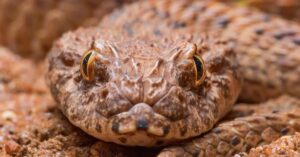
The death adder is a highly venomous snake found in Australia and New Guinea. Known for its potent venom and deadly strike, the Death Adder is one of the most feared snakes in the region. The Death Adder is a member of the Elapidae family, which includes other highly venomous snakes such as the Cobra and the Taipan. This snake gets its name from its deadly strike, which can kill a human in as little as six hours. Its venom is a potent neurotoxin that attacks the nervous system, causing paralysis and eventual death if left untreated. Despite its fearsome reputation, the Death Adder is actually a shy and elusive snake. It spends much of its time lying in wait for prey, using its camouflaged body to blend into its surroundings. When a potential meal comes within striking distance, the Death Adder will lunge forward with lightning speed, injecting its venom into the victim before retreating to safety. The Death Adder primarily preys on small mammals, birds, and reptiles, using its venom to immobilize its prey before consuming it whole. It is an ambush predator, relying on stealth and surprise to catch its meals. In addition to its deadly venom, the Death Adder also has specialized adaptations for hunting. Its tail has a series of black and white bands that mimic the appearance of a worm, attracting prey such as lizards and frogs. This deceptive tactic allows the Death Adder to lure in unsuspecting victims before striking with deadly accuracy. Despite its deadly reputation, encounters with the Death Adder are rare. This snake is usually only aggressive when threatened or cornered, preferring to avoid confrontation with humans. When in areas where the Death Adder resides, exercise caution, as its venom can be fatal without prompt treatment.
9. Russell Viper
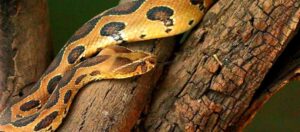
Russell’s viper, also known as the Indian Russell’s viper, is a highly venomous snake that is native to the Indian subcontinent and Southeast Asia. This species, named after British herpetologist Dr. Patrick Russell, is widely feared for its aggressive nature and potent venom. One of the largest vipers in the world, Russell’s viper can grow up to 5 feet in length and has a distinct triangular-shaped head, which is characteristic of vipers. Its coloration can vary from shades of brown to gray with dark markings along its body, providing effective camouflage in its natural habitat of grasslands, forests, and agricultural areas. Known for its quick strike and powerful venom, Russell’s viper is responsible for a significant number of snakebite fatalities in its range. Its venom contains a potent cocktail of toxins that affect the victim’s blood vessels, causing severe internal bleeding, tissue damage, and organ failure. Without prompt medical treatment, a bite from this viper can be deadly. Despite their fearsome reputation, Russell’s vipers play a crucial role in their ecosystem as top predators, helping to control the populations of rodents and other small animals. Scientists and researchers study the composition of venom, which are essential subject for them, in order to develop antivenom treatments and counteract its effects. When walking in grassy fields, rocky outcrops, and forested regions, exercise caution to avoid encounters with Russell’s vipers. Wearing appropriate footwear, using a flashlight at night, and staying on designated paths can help reduce the risk of accidental bites. If you do happen to come across a Russell’s viper, it is important to remain calm and slowly back away from the snake to avoid provoking it. These vipers are generally not aggressive unless threatened or provoked, so giving them space to retreat will help prevent any potential conflict. In the event of a snakebite from a Russell’s viper, seeking immediate medical attention is crucial. Antivenom treatment is available in hospitals and clinics throughout the viper’s range, and prompt administration can greatly improve the chances of recovery for the victim. Russell’s viper serves as a reminder of the importance of respecting and coexisting with the diverse wildlife that inhabits our planet. By learning to recognize and understand these fascinating creatures, we can better appreciate their role in the ecosystem and take appropriate precautions to ensure our safety and well-being.
10. Many banded Krait
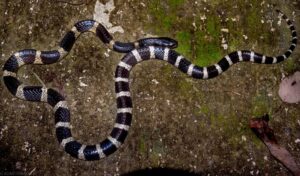
The Many-Banded Krait is a nocturnal creature, preferring to hunt and move around under the cover of darkness. It is a highly venomous snake with potent neurotoxic venom that can quickly incapacitate its prey. The Many-Banded Krait, known for its deadly capabilities, becomes aggressive and strikes only when provoked or threatened.One of the most fascinating aspects of the many-banded krait is its unique hunting behavior. Unlike most snakes, which actively track down their prey, the many-banded krait uses a sit-and-wait strategy to catch its meals. It coils itself up and waits for unsuspecting prey to come within striking distance, using its powerful venom to immobilize and subdue its victims.In terms of physical characteristics, the many-banded krait is a relatively small snake, averaging around 3 to 4 feet in length. It has a slim body with a distinctively triangular head, equipped with potent venom glands. Its banded coloring, alternating between black and white stripes, serves as a warning signal to potential predators, showcasing its lethal nature.The many-banded krait is an important species in its natural ecosystem, playing a crucial role in controlling populations of rodents and other small mammals. However, due to habitat destruction and human encroachment, the population numbers of this species have been declining in recent years. We are making conservation efforts to protect the habitat of the Many-banded Krait and raise awareness about the importance of preserving this unique snake species.


